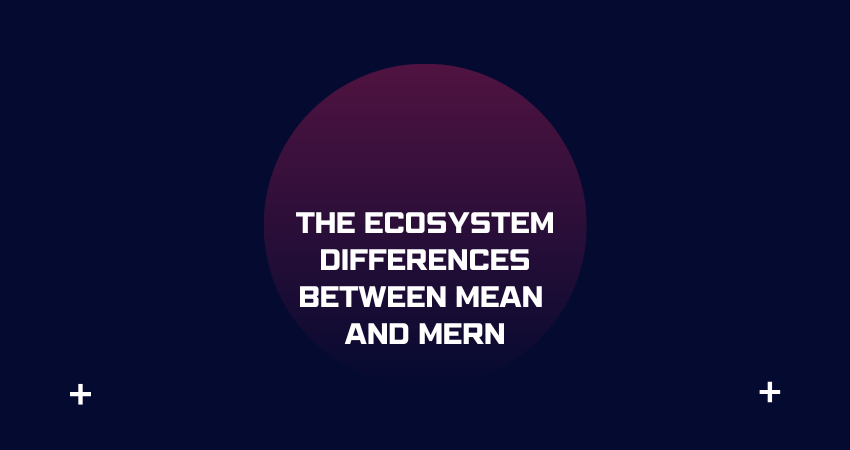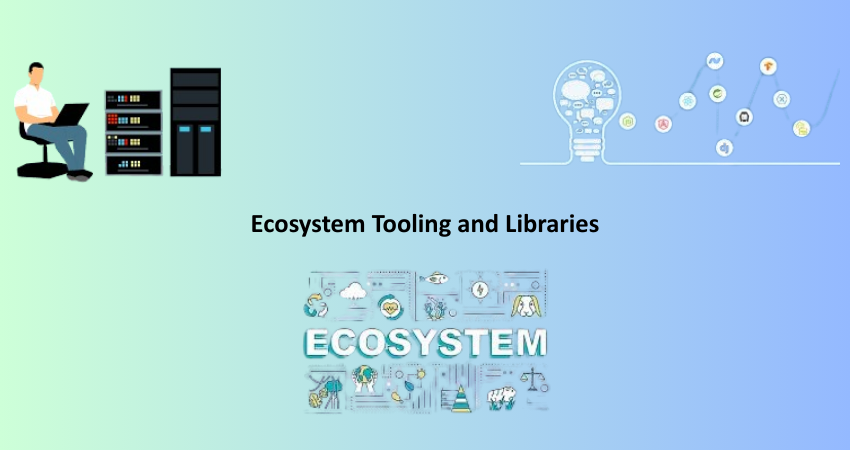
Introduction
Full-stack JavaScript frameworks have completely changed how applications are developed and deployed in the fast-evolving world of web applications. Two of the most widely used full-stack frameworks are MEAN and MERN stacks. With a lot of overlapping structure and the same philosophical inclination, MEAN and MERN differ in their ecosystems and developer experiences. MEAN stack is an acronym for MongoDB, Express.js, Angular, and Node.js; whereas MERN stack replaces Angular with React, thus MongoDB, Express.js, React, and Node.js. Both stacks offer excellent end-to-end JavaScript-based solutions, but different front-end frameworks create greatly different ecosystem characteristics, workflows, and developer preferences.
Developers, teams, and companies wishing to make the correct choice for their project should know the ecosystem disparities between MEAN and MERN; this choice is critical since it determines the architecture and scalability of your application and development hours, talent acquisition, and future maintainability. Angular and React represent two opposing schools of thought in client-facing development-one a full-on framework and the other a flexible library. These contrary paradigms have ramifications across this entire ecosystem with a bearing on application architecture, state management, and toolbox selections. This article will dive deeply into the ecosystem-level differences between MEAN and MERN to equip you with the understanding to make an informed decision.
Front-End Framework Philosophy
Angular in MEAN: Full Framework Approach
Angular is the front end of the MEAN stack; it is thus an opinionated and complete framework developed and maintained by Google. It provides a set of rich tools, services, and best practices that promote consistency and scalability. From the beginning of a new Angular project using the Angular CLI, a developer receives a consistent project structure, dependency injection, routing, form management, and a strong templating engine. The built-in rigidity makes Angular fit for enterprise applications specializing in predictability of the structure of the code and team collaboration.
It encourages the Model-View-Controller (MVC) architectural pattern. Angular has incorporated all features like two-way data binding, reactive forms, services, and modules that enforce separation of concerns and coding in a modular way. Maintenance and scaling of the application take place over time by different teams. It enables server-side rendering with Angular Universal, UI components with Angular Material, and takes care of advanced navigation features with the Angular Router. For a MEAN stack developer, this is a complete, mature, structured development environment with fewer external decisions for large teams involved.
React in MERN: Library-First Flexibility
React, the front-end element of the MERN stack, is a JavaScript library developed by Facebook for building user interfaces. Unlike Angular, React is not a full framework but rather a highly focused tool for constructing UI components. This library-first philosophy offers developers a high degree of freedom to choose their own libraries and tools for handling tasks like routing, state management, and form validation. This architecture supports a React component which gives an option for the developers to reuse components for isolated maintenance and scalability in their codes.
The MERN stack: This is when developers start adding their own work with an additional external library integration like React Router for routing, Redux or Context API for state management, Formik or React Hook Form for Forms handling, or whatever else they might be using. This modularity provides a customizable development experience but requires more upfront decision-making and configuration than what is achievable with Angular. The upside is a lightweight, highly responsive front end with greater control over how the application can evolve. This is the perfect approach for startups, SPAs, and teams that would like to customize their tech stack rather than follow a rigid structure.
Ecosystem Tooling and Libraries

MEAN Stack Ecosystem: Integrated Tooling and Best Practices
Angular’s opinionatedness, extending even to its ecology or tooling, is one of its merits in the MEAN stack. Angular CLI is a powerful command line to simplify most of the development workflow, right from component generation to testing setup and production builds. It enhances convenience for developers, enabling them to scaffold new features quickly but with completeness according to Angular best practices and thus uniformity across codebases of large size. This kind of development is CLI-centric, taking away much of the time spent toward configuring things, hence adding more productivity and benefits, especially in team environments where standardization is critical.
Another advantage of the MEAN ecosystem is that it offers an entire plethora of official libraries and integrations. With Angular Material, developers can find a set of UI components for their applications with implemented designs conforming to the Google Material Design guidelines, thus implementing good-looking interfaces without the need to rely on other libraries. Furthermore, RxJS serves the notion of reactive programming, as well as closely coupled into an architecture of Angular for asynchronous data streams. This ecosystem edges out TypeScript, thus giving JavaScript static typing and better tooling. All these combine to form a robust integrated environment on enterprise applications that are testable, scalable, and maintainable.
MERN Stack Ecosystem: Decentralized and Community-Driven
The MERN assemblages comprise entirely free and highly modular systems; they are community-driven because of the flexible nature of React. Architecturally, React leaves no bounds, thus allowing programmers the freedom to shape their stack of tools and libraries. It thus fosters innovation, creativity, and rapid adoption to new techniques. There are tools that are present among all MERN projects, such as Vite, Webpack, and Babel, whose purposes include providing bundling and transpiling. Redux Toolkit, MobX, or Recoil can also be put into the bag for advanced state management, depending on how complex the project is.
Such a large number of open-source contributions benefit the React ecosystem; hence, for most functionalities, there would always be a library or plugin available. This drastically reduces the development time and even offers cutting-edge features that more monopolistic ecosystems like Angular might not yet have. MERN developers also enjoy the freedom to choose CSS frameworks, testing libraries (like Jest or React Testing Library), and options like Next.js for server-side rendering. While this much freedom can be a bit overwhelming for a beginner, for experienced developers, this flexibility is perhaps the most major positive factor to consider when creating applications with a high level of customization and optimization.
Learning Curve and Developer Experience
Structured Learning with Angular and MEAN
Angular is a complete framework, which offers a harsh learning curve mostly for beginners. There are multiple Angular-specific concepts that will require proper understanding of the beginners. These include: decorators, dependency injection, RxJS observables, TypeScript, and Angular modules. That is exactly what this structure offers, and it favors long-term development. The consistent patterns and idioms of Angular can later quicken the collaborative efficiency of the teams and make it easier to onboard new developers. It is the purest environment of full-stack development since every part complements the other, making it redundant to decide elsewhere.
The MEAN ecosystem offers an organized learning path, especially appealing for academic and corporate training. Extensive documentation from Google guarantees stability and assurance in the framework’s long-term support. Besides, interoperability with TypeScript minimizes runtime errors and enables better code documentation, promoting maintainability. Angular has a steeper learning curve, but then the dividend is paid in the form of a high-performance framework with tools and guidelines that greatly reduce the complexity of application-building tasks from then on.
React’s Progressive Learning Curve in MERN
On the other hand, React has an easier environment to begin with. A developer can create components with JavaScript just by using very basic information of JSX syntax (and this is to a front-end developer quite intuitive) that resembles HTML at times. Consequently, as one builds bigger projects, more advanced topics such as hooks, context, refs, and performance optimization get gradually introduced in the development life cycle. This is good for individuals and small teams who want to kickstart their journey and eventually build skill sets. MERN gives a more flexible learning path where a developer can learn and start using new tools when required.
From the viewpoint of the developer, the MERN stack is flexible with a very supportive community. Documentation is usually fortified with an exhaustive amount of community blogs, YouTube tutorials, and GitHub repositories. React’s popularity guarantees continuous streams of tools, extensions, and best practices that developers pick up depending on their current project needs. On the one hand, these agreements and conventions may be avoided in large teams leading to inconsistency. On the other hand, ESLint, Prettier, and other clearly defined architecture patterns can help smoothen these rough edges. These attributes make the MERN stack extremely suited for rapid prototyping and any project where flexibility and creativity are paramount.
Performance and Scalability Considerations

MEAN Stack: Consistent Performance at Scale
Meaning every respect stack is a realistic one when it comes to performance and scalability, especially in structured environments for enterprises, but it is to be derailed and optimized well. Pre-compilation (i.e., ahead-of-time compilation or AOT) in Angular reduces application size and runs much faster as templates are compiled at build instead of at runtime. Angular has a change detection feature, which is sometimes debated for its complexity, yet it is very powerful in combining the best practices like On Push strategies and immutable data patterns to maintain performance with the ever-increasing size of applications.
When it comes to throws and scalability, with Angular’s module architecture, this is a clear separation of concerns suitable for teamwork and further feature enhancements. Node.js and Express provide services on the backing with a non-blocking I/O model supporting the handling of multiple simultaneous connections, thus offering the MEAN platform for large applications like dashboards, content management systems, and internal enterprise tools. The scalability of MongoDB, in addition to the flexibility in storing JSON-like documents, makes this stack so that all pipeline networks efficiently support large amounts of data and users.
MERN Stack: Lightweight and High-Performance
MERN is the stack that truly excels at providing lean, fast applications, particularly for single-page applications and mobile-first projects. React’s virtual DOM makes it as efficient in updates and rendering as can be imagined, leading to snappy UIs under actual, dynamic conditions. React isn’t like Angular, which locks one into a certain structure; rather, it grants the developer more control to tune performance characteristics through memoization, lazy loading, and code splitting-in-the-dark with the dynamic import() statements. Thus, such management leads to less time in terms of payload to load and better perceived performance.
Sandbox support in MERN is also about flexibility and modern tools. For instance, Next.js brings SSG, SSR, and API routes that enable applications to be optimized and scaled according to geographies and devices. These combined with MongoDB, Express, and Node.js provide the powerful back-end akin to MEAN to deliver data efficiency in networks and integrity. With a stack specifically designed for fast iteration cycles, real-time updates, and a tailor-made experience for the user, the MERN stack would be best suited for SaaS-type scenarios: social apps and marketplaces.
Conclusion
To evaluate MERN or MEAN for the developer’s need, the choice cannot be decided by mere substitution of Angular with React. Therefore, things like developer experience, tooling within the ecosystem, scalability parameters, and finally, performance aspects will play an essential role throughout that journey. The MEAN stack offers a way more opinionated and tightly integrated structure offering a working style with the environment and tools, which are suitable for enterprise applications. Here, the primary concerns take into account things like consistency, type safety, and long-term responsibility. Angular’s steepness and TypeScript drive a more advanced learning curve, but constrain via development discipline and soundness. Such a disciplined and well-structured path is particularly beneficial for large teams developing applications with complex requirements and high internal standards and a unified development approach.
The flip side is that MERN supports architecting applications in a highly modular way, thereby being flexible enough to allow for rapid development of highly custom applications using multiple community-supported tools through the React-based ecosystem. In short, this stack suits projects focused on speed, innovation, and customer-side performance like a glove. Light learning curves and resource availability make this particular stack very attractive for startups, freelance developers, and agile teams. The MERN approach allows developers to choose their tools, play with new technologies, and quickly prototype ideas without confining into a rigid framework. This definitely makes MERN an all-time favorite for the newer generation of web applications that require constant iteration and personalizing UX.